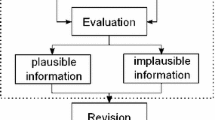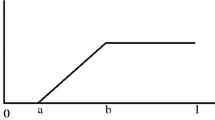Abstract
Given a belief function ν on the set of all subsets of prizes, how should ν values be understood as a decision alternative? This paper presents and characterizes an induced-measure interpretation of belief functions.
Similar content being viewed by others
References
Chateauneuf, A. and Jaffray, J-Y. (1989), Some characterizations of lower probabilities and other monotone capacities through the use of Möbius inversion, Mathematical Social Sciences 17, 263–283.
Dynkin, E.B. (1965), Markov Processes, Vol. II, Springer.
Epstein, L.G. and Zhang, J. (2001), Subjective probabilities on subjectively unambiguous events, Econometrica 69, 265–306.
Fishburn, P.C. (1982), The Foundations of Expected Utility, D. Reidel, Dordrecht, Holland.
Ghirardato, P. (2001), Coping with ignorance: unforeseen contingencies and non-additive uncertainty. Economic Theory 17, 247–276.
Hendon, E., Jacobsen, H.J., Sloth, B. and Tranaes, T. (1994), Expected utility with lower probabilities, Journal of Risk and Uncertainty 8, 197–216.
Jaffray, J-Y. (1989), Linear utility theory for belief functions, Operations Research Letters 8, 107–112.
Jaffray, J-Y. (1991), Linear utility theory and belief functions: a discussion, in A. Chikan (ed.), Progress in Decision, Utility and Risk Theory, Kluwer Academic, pp. 221–229.
Jaffray, J-Y. and Wakker, P. (1993), Decision making with belief functions: compatibility and incompatibility with the sure-thing principle, Journal of Risk and Uncertainty 7, 255–271.
Mukerji, S. (1997), Understanding the non-additive probability decision models, {tiEconomic Theory} 9, 23–46.
Shafer, G. (1976), A Mathematical Theory of Evidence, Princeton University Press, Princeton, NJ. Princeton University Press (1953, 3rd ed.).
Suppes, P. (1966), The probabilistic argument for a non-classical logic of quantum mechanics, Philosophy of Science 33, 14–21.
Wakker, P. (2000), Dempster-belief functions are based on the principle of complete ignorance, International Journal of Uncertainty, Fuzziness and Knowledge-Based Systems 8, 271–284.
Zhang, J. (1999), Qualitative probabilities on λ-system, Mathematical Social Sciences 38, 11–20.
Author information
Authors and Affiliations
Corresponding author
Rights and permissions
About this article
Cite this article
Nakamura, Y. Objective Belief Functions as Induced Measures. Theory and Decision 55, 71–83 (2003). https://doi.org/10.1023/B:THEO.0000019053.53742.37
Issue Date:
DOI: https://doi.org/10.1023/B:THEO.0000019053.53742.37




